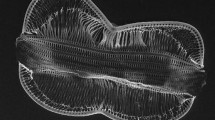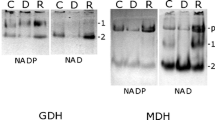Abstract
The responses of cellular C and N, pigments and growth rates of Alexandrium tamarense to different sources of N at high concentrations (6, 12, 25, 50 and 100 μM-N) were examined. Nitrate induced the highest concentration of cellular C (an indicator of biovolume) and cellular N, followed by ammonium and then urea. Cellular C to N ratio (an indicator of physiological status) also varied between N sources. Nitrate grown cells had lower range of C:N ratios and ammonium grown cells had highly variable range. Urea cultures had the highest range of cellular C:N ratio. Pigment composition remained unchanged with all N substrates. The pigments decreased with increasing nitrate concentrations, but with ammonium pigments increased. On the other hand, urea concentrations had no clear relationship with cellular pigments. Variability in the growth of cells was due to both the physiological condition and pigments. When the cells are exposed to different N environments and concentration, they exhibit a physiological acclimation by regulating their cellular materials which is associated with growth.
Similar content being viewed by others
References
Anderson, D. M., 1997. Bloom dynamics of toxic Alexandrium species in the northeastern U.S. Limnology and Oceanography 42: 1009–1022.
Chang, F. H. & M. McClean, 1997. Growth responses of Alexandrium minutum (Dinophyceae) as a function of three different nitrogen sources and irradiance. New Zealand Journal of Marine and Freshwater Research 31: 1–7.
Chang, F. H. & M. Page, 1995. Influence of light and three nitrogen sources on growth of Heterosigma carterae (Raphidophyceae). New Zealand Journal of Marine and Freshwater Research 29: 299–304.
Cochlan, W. P., N. M. Price & P. J. Harrison, 1991. Effects of irradiance on nitrogen uptake by phytoplankton: comparison of frontal and stratified communities. Marine Ecology Progress Series 69: 103–116.
Collos, Y. & G. Slawyk, 1980. Nitrogen uptake and assimilation by marine phytoplankton. In Falkowski, P. G. (ed.), Primary productivity in the sea. Plenum, New York: 195–211.
Cullen, J. J. & S. G. Horrigan, 1981. Effects of nitrate on the diurnal vertical migration, carbon to nitrogen ratio, and the photosynthetic capacity of the dinoflagellate Gymnodinium splendens. Marine Biology 62: 81–89.
Dortch, Q., J. R. Clayton Jr., S. S. Thoresen, & S. I. Ahmed, 1984. Species differences in accumulation of nitrogen pools in phytoplankton. Marine Biology 81: 237–250.
Dugdale, R. C. & J. J. Goering, 1967. Uptake of new and regenerated forms of nitrogen in primary productivity. Limnology and Oceanography 12: 196–206.
Eppley, R. W., C. Sapienza & E. H. Renger, 1978. Gradients in phytoplankton stocks and nutrients off California in 1974-1976. Estuarine Coastal Marine Science 7: 291–301.
Flynn, K. J. & K. Flynn, 1995. Dinoflagellate physiology: nutrient stress and toxicity. In Lassus, P., G. Arzul, E. Erard-Le Denn, P. Gentien & C. Marcaillou-Le Baut (eds), Harmful Marine Algal Blooms. Lavoisier, France: 541–550.
Geider, R. J. & H. L. MacIntyre, 2002. Physiology and biochemistry of photosynthesis and algal carbon acquisition. In Williams, P. J. I. B., D. N. Thomas & C. S. Reynolds (eds), Phytoplankton productivity: Carbon Assimilation in Marine and Freshwater Ecosystems. Blackwell Science, Oxford: 44–77.
Geider, R. J., H. L. MacIntyre, T. M. Kana, 1996. A dynamic model of photoadaptation in phytoplankton. Limnology and Oceanography 41: 1–15.
Geider, R. J., H. L. MacIntyre & T. M. Kana, 1998. A dynamic regulatory model of phytoplanktonic acclimation to light, nutrients, and temperature. Limnology and Oceanography 43: 679–694.
Geider, R. J. & B. A. Osborne, 1992. The photosynthesis-light response curve. In Geider, R. J. & B. A. Osborne (eds), Algal photosynthesis: the measurement of algal gas exchange. Chapman & Hall, New York: 156–191.
Goldman, J. C. & P. M. Glibert, 1983. Kinetics of inorganic nitrogen uptake by phytoplankton. In Carpenter, E. J. & D. G. Capone (eds), Nitrogen in the Marine Environment. Academic Press, New York: 233–274.
Guillard, R. R. & J. H. Ryther, 1962. Studies of marine planktonic diatoms. 1. Cyclotella nana Hustedt and Detonula confervacea (Cleave.) Gran. Canadian Journal of Microbiology 8: 229–239.
Hallegraeff, G. M. 1995. Harmful algal blooms: A global overview. In Hallegraeff, G. M., D. M. Anderson & A. D. Cembella (eds.), Manual on Harmful Marine Microalgae: IOC Manuals and Guides No. 33. UNESCO: 1-18.
Hamasaki, K., M. Horie, S. Tokimitsu, T. Toda & S. Taguchi, 2001. Variability in toxicity of the dinoflagellate Alexandrium tamarense isolated from Hiroshima Bay, western Japan, as a reflection of changing environmental conditions. Journal of Plankton Research 23: 271–278.
Head, E. J. H. & E. P. W. Horne, 1993. Pigment transformation and vertical flux in an area of convergence in the North Atlantic. Deep Sea Research II 40: 329-346.
Howarth, R. W., G. Billen, D. Swaney, A. Townsend, N. Jaworski, K. Lajtha, J. A. Downing, R. Elmgren, N. Caraco, T. Jordan, F. Berendse, J. Freney, V. Kudeyarov, P. Murdoch & Z. L. Zhu, 1996. Regional nitrogen budgets and riverine N and P fluxes for the drainages to the North Atlantic Ocean: natural and human influences. Biogeochemistry 35: 75–139.
John, E. H. & K. J. Flynn, 2000. Growth dynamics and toxicity of Alexandrium fundyense (Dinophyceae): the effect of changing N:P supply ratios on internal toxin and nutrient levels. European Journal of Phycology 35: 11–23.
Kudela, R. M. & W. P. Cochlan, 2000. Nitrogen and carbon uptake kinetics and the influence of irradiance for a red tide bloom off southern California. Aquatic Microbial Ecology 21: 31–47.
McCarthy, J. J. & D. Kamykowski, 1972. Urea and other nitrogenous nutrients in La Jolla Bay during February, March, and April 1970. Fishery Bulletin US 70: 1261–1274.
MacIsaac, J. J. & R. C. Dugdale, 1969. The kinetics of nitrate and ammonium uptake by natural populations of marine phytoplankton. Deep Sea Research 16: 45–57.
Matsuoka, K., 1999. Eutrophication process recorded in dinoflagellate cyst assemblages-a case of Yokohama Port, Tokyo Bay, Japan. Science of the Total Environment 231: 17–35.
Menden-Deuer, S. & E. J. Lessard, 2000. Carbon to volume relationships for dinoflagellates, diatoms, and other protist plankton. Limnology and Oceanography 45: 569–579.
Middelburg, J. J. & J. Nieuwenhuize, 2000. Uptake of dissolved inorganic nitrogen in turbid, tidal estuaries. Marine Ecology Progress Series 192: 79–88.
Montagnes, D. J. S. & J. A. Berges, 1994. Estimating carbon, nitrogen, protein, and chlorophyll a from volume in marine phytoplankton. Limnology and Oceanography 39: 1044–1060.
Nagao, N., T. Toda, K. Takahashi, K. Hamasaki, T. Kikuchi & S. Taguchi, 2001. High ash content in net-plankton samples from shallow coastal water: Possible source of errors in dry weight measurement of zooplankton biomass. Journal of Oceanography 57: 105–107.
Paerl, H. W., 1997. Coastal eutrophication and harmful algal blooms: Importance of atmospheric deposition and groundwater as “new” nitrogen and other nutrient sources. Limnology and Oceanography 42: 1154–1165.
Pandian, J. J., 1975. Mechanisms of heterotrophy. In Kinne, O. (ed.), Marine Ecology, Vol. 2. Wiley, New York: 179–188.
Parkhill, J. P. & A. D. Cembella, 1999: Effects of salinity, light and inorganic nitrogen on growth and toxigenicity of the marine dinoflagellate Alexandrium tamarense from northeastern Canada. Journal of Plankton Research 21: 939–955.
Présing, M., S. Herodek, L. Vörös, T. Preston & G. Abrusán, 1999. Nitrogen uptake by summer phytoplankton in Lake Balaton. Archiv für Hydrobiologie 145: 93–110.
Richard, F. A., 1981. Coastal Upwelling. American Geophysical Union, Washington, D.C., 529 pp.
Seitzinger, S. P., R.W. Sanders & R. Styles, 2002. Bioavailability of DON from natural and anthropogenic sources to estuarine plankton. Limnology and Oceanography 47: 353–366.
Smayda, T. J., 1990. Novel and nuisance phytoplankton blooms in the sea. Evidence for a global epidemic. In Granéli, E. P., B. Sundström, L. Edler & D. M. Anderson (eds.), Toxic Marine Phytoplankton. Elsevier, New York: 29–41.
Syrett, P. J., 1981. Nitrogen metabolism of microalgae. Canadian Bulletin of Fishery and Aquatic Science 210: 182–210.
Wheeler, P. A., 1983. Phytoplankton nitrogen metabolism. In Carpenter, E. J. & D. G. Capone (eds), Nitrogen in the Marine Environment. Academic Press, New York: 309–346.
Author information
Authors and Affiliations
Rights and permissions
About this article
Cite this article
Chee Yew Leong, S., Taguchi, S. Response of the dinoflagellate Alexandrium tamarense to a range of nitrogen sources and concentrations: growth rate, chemical carbon and nitrogen, and pigments. Hydrobiologia 515, 215–224 (2004). https://doi.org/10.1023/B:HYDR.0000027331.49819.a4
Issue Date:
DOI: https://doi.org/10.1023/B:HYDR.0000027331.49819.a4




